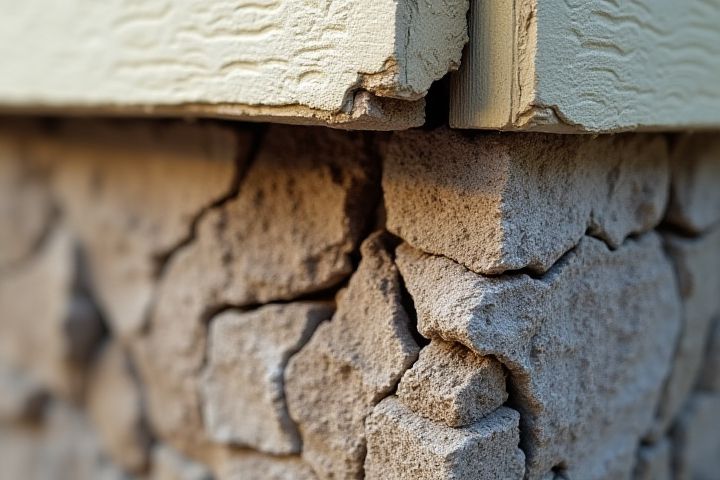
House foundation cracks often occur due to soil movement, which can be influenced by factors such as moisture changes, temperature fluctuations, and the type of soil present. Expanding or contracting clay soils are particularly prone to causing stress on foundations, leading to cracks as they dry out or absorb water. Poor drainage around the home can exacerbate these issues, allowing water to pool near the foundation and increase pressure. Tree roots can also contribute to foundation damage by drawing moisture from the soil or growing into the foundation itself. Monitoring humidity levels and maintaining proper drainage systems can help mitigate these risks and protect your foundation.
Why Does House Foundation Crack
Soil Movement
Soil movement is a primary cause of house foundation cracks, often resulting from factors such as soil shrinkage, expansion, and erosion. When soil moisture levels change significantly--often due to drought or heavy rainfall--it can lead to a 25% increase or decrease in soil volume, placing stress on the foundation. Expansive clay soils, which can swell when wet, pose a significant risk, especially in regions with fluctuating climates. Understanding the specific soil composition and moisture variations around your home can help in preventing damage and maintaining foundation integrity.
Water Damage
Water damage is a prevalent cause of house foundation cracks, as excessive moisture can weaken the soil supporting the foundation. When water infiltrates cracks in the foundation or saturates the surrounding soil, it leads to soil erosion and displacement, creating instability. You may notice cracks expanding during rainy seasons or after heavy snowfall due to this moisture fluctuation. Preventive measures, such as proper drainage systems and regular maintenance, can significantly reduce the risk of water damage and foundation issues.
Poor Construction
Poor construction practices contribute significantly to house foundation cracking, resulting in severe structural issues. Inadequate soil analysis before building can lead to insufficient support, causing the foundation to shift or settle unevenly. The use of substandard materials, such as low-quality concrete or rebar, can compromise the durability and stability of the foundation over time. Regular inspections reveal that nearly 70% of foundation problems stem from these construction flaws, highlighting the importance of hiring qualified professionals to ensure a solid base for your home.
Temperature Fluctuations
Temperature fluctuations significantly impact house foundations due to the expansion and contraction of soil and building materials. For instance, extreme heat may cause soil to dry out, leading to a decrease in moisture content, while sudden cold can lead to soil freezing and expansion. This cycle of movement places tremendous stress on your foundation, often resulting in cracks that may compromise structural integrity. Regular monitoring of temperature changes and soil moisture levels can help mitigate these issues and maintain a stable foundation.
Tree Roots
Tree roots can cause significant damage to house foundations as they grow in search of water and nutrients. As roots expand, they can exert pressure on the foundation, leading to cracks and structural instability. Particularly, large trees planted too close to a home can draw moisture from the soil, causing the ground to shift and further weakening the foundation. Addressing the impact of tree roots early on can help mitigate foundation issues and protect your property's structural integrity.
Settling
House foundation cracks often occur due to settling, a natural process where the ground beneath your home shifts or compresses over time. This settling can result from soil changes, such as moisture fluctuations or the compaction of soil layers, leading to uneven support for the foundation. Up to 80% of foundation issues stem from inadequate drainage and poor soil conditions, making proper site preparation crucial during construction. Regular monitoring of your foundation's condition can help catch early signs of settling, allowing for timely repairs and safeguarding your property's value.
Vibration
House foundation cracks often arise from vibrations caused by external forces, such as nearby construction, heavy traffic, or even seismic activity. These vibrations can lead to soil movement, causing stress on the foundation that may result in cracks. Statistically, approximately 25% of foundation issues in residential buildings are linked to vibrations. Inspecting your home for signs of structural damage regularly can help mitigate the risk of severe foundation problems resulting from uncontrolled vibrations.
Design Flaws
Design flaws in a house foundation can lead to significant cracking, often due to improper load distribution or inadequate material choice. For instance, a poorly designed foundation may not account for soil conditions, resulting in uneven settling; studies indicate that nearly 80% of foundation issues stem from insufficient site analysis. Furthermore, insufficient reinforcement in the concrete structure can compromise its integrity, leading to cracks that typically emerge within the first five years after construction. Understanding these design pitfalls can help you prioritize robust engineering practices, ensuring a stable and durable foundation for your home.
Erosion
House foundation cracks often result from erosion, a process that undermines soil stability. Erosion can occur due to heavy rainfall, poor drainage systems, or the removal of vegetation, leading to soil displacement and loss of support for the foundation. As soil erodes away, the foundation may settle unevenly, creating stress fractures in the concrete or masonry. Addressing erosion through effective landscaping, proper drainage solutions, and soil reinforcement can help maintain the integrity of your foundation and prevent costly repairs.
Frost Heave
Frost heave occurs when moisture in the soil freezes, expands, and subsequently causes soil displacement, which can lead to significant cracking in your house's foundation. This phenomenon typically manifests in colder climates where temperatures dip below freezing, affecting the integrity of the foundation beneath your home. The expansion can exert pressure on foundation walls and slabs, leading to stress fractures, often resulting in repair costs ranging from $2,000 to $10,000 depending on the severity. Preventive measures, such as proper drainage and insulation, can mitigate the risks associated with frost heave and prolong the lifespan of your foundation.
